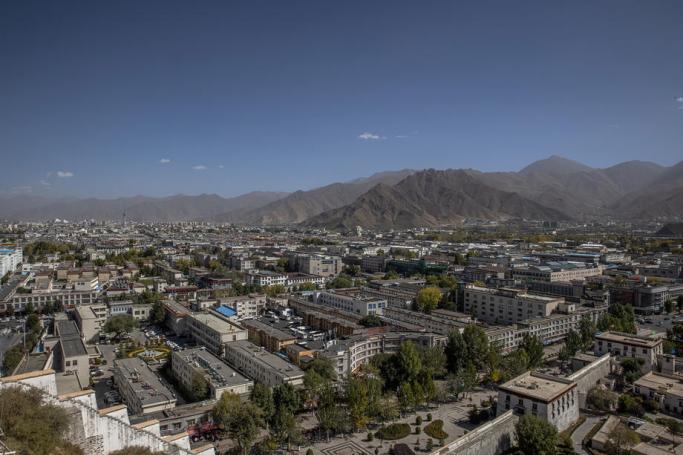It has been decades since China’s occupation of Tibet and it is apparent that the Chinese communist government has uprooted Tibet off its authenticity and essence. The cultural, traditional and environmental impacts are visible. The People’s Republic of China (PRC) has always claimed the land of Tibet as their own and has also stated that they have only brought immense improvement to Tibet. The fact that the Tibetans in Tibet are robbed of the basic human rights is a well-known issue. The land which is called “The roof of the world” has been stripped off its stature. China’s thirst for power and their greed has destroyed the land of Tibet through excessive mining and damming. Tibet has always been a land filled with rich natural resources and has its contribution to the flawless flow of some rivers. However, China’s so-called “revolution” has brought more harm than ever.
Air and water pollution has become a common issue which sees no significant improvement. The forceful displacement of Tibetans due to excessive damming has caused tremendous problems for the locals and has rendered them homeless. The forceful abolishment of the nomadic life has also resulted in the degradation of the quality of the land that the nomads once used to raise their livestock and did farming in. The damming issue specifically has stirred quite an issue. The communist party’s plan regarding the construction of a dam and a hydropower project on the Yarlung Tsangpo River, which becomes the Brahmaputra River in India and Bangladesh sparked concerns over massive environmental destruction and downstream water shortages this year. It was seen as a bigger issue than the controversial ‘Three Gorges Dam’ which is one of the largest ever created dams. It was built across the Yangtze River to control the amount of water allowed through, creating a gigantic ‘artificial lake’. Hydrology experts called out the danger of such a dam and the lives that were at risk but China still dotes on their plans to continue with their damming plans. "Scientists have warned that constant construction of hydropower dams will lead to earthquakes, landslides and also submerge land and forests underwater, which will endanger wildlife," Zamlha Tenpa Gyaltsen, environmental analyst at the Dharamsala-based Tibet Policy Institute, told RFA in an interview. He also added that it can lead to water shortages and floods in the area which would eventually result in huge environmental destruction. It would also impact India through the flow of the rivers.
China is also aware of the implications but it also makes it possible for them to displace the Tibetans and then resettle their people in the lands once owned by the Tibetans. Their political motive behind it is also focused solely on the benefits of their land and their people. China’s plan to build more artificial lakes has merely been for tourism. They claim to make the water quality better but it has only caused degradation and has robbed places like Lhasa off their real touristy values. The construction of hydropower dams in Lhasa resulted in the degradation in the quality of the water which was initially used by Tibetans as a source of drinking water and by Tibetan farmers for irrigation.
Like the impacts on the river flow in India, China’s extensive damming of the upper Mekong River has also reduced water flows and threatened downstream countries Cambodia and Vietnam with environmental harm and food shortages. The Mekong-Lancang summit couldn’t provide insight or solution since China had an upper hand on the matter with China being the host and the owner of the dams upriver. The counties that have to brace the impact are bound to face serious water shortages which would gradually lead to a troublesome issue in their economy.
China has already caused such damage in Tibet and is bent upon doing the same with other countries at hand. The Tibetans in Tibet have fallen prey to the communist government’s repressive policies and plans for decades. The struggle to get our land back is own but the visible damages being done to the land or the immense harm caused upon our people is aggravating and depressing. The landscape and environment that Tibet once stood proud for are on the verge of destruction. The livelihoods of the Tibetans have been scarred and forcefully deprived off. The natural resources will also go extinct soon and the flow of the rivers will be met with dire implications as well. The excessive, harmful projects of the PRC will continue and Tibet will witness the death of its land at this cost. The environmental impacts are evident and supported by the impacts that it has on the other countries at risk. It is time to raise such issues on the international forums so that the PRC can pay for the implications and stop immediately with any plan which may have an impact on the environment. India also stands at a high risk of facing problems with the river flow if China continues to build more dams and carry forward with more hydropower projects in the coming years. Its influence on the economy, later on, is foreseeable but avoidable at this stage. Tibetans have faced enough with China’s annexation and their constant threat to the people inside Tibet. The land, however, should not have to go through such adversities, the effects of Global warming is prominent and on top of that, China’s idiotic plan to cause further destruction to the land and the rivers is highly unwanted. Excessive mining and damming have to stop. Tibetans have begged for international support regarding our cause and we also extend our hands to gain support to put an end to this environmental assassination. The rivers, the land and its people should be taken care of at all costs.
It is in the interest of all humankind to pressurise China to stop the destruction of the environment on the Tibetan plateau.
Lee Chen is a pseudonym for a writer covering Asia and world politics












